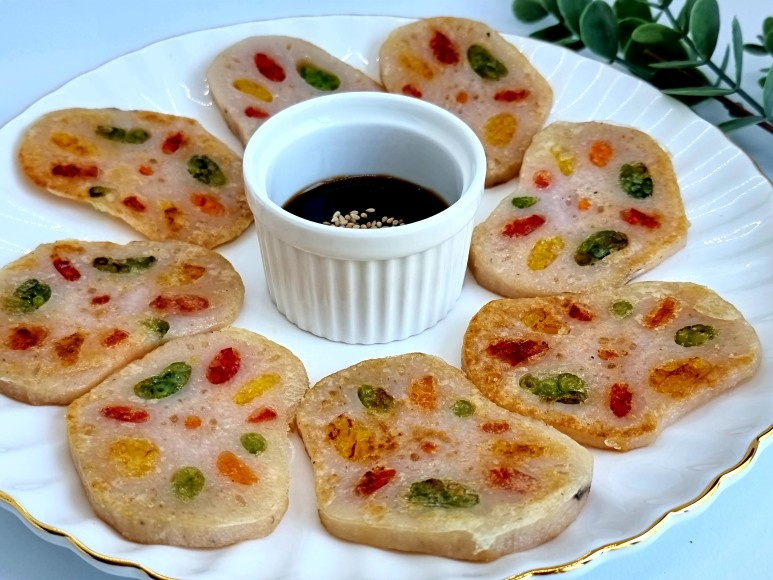Colorful Lotus Root Flower Jeon (Korean Pancake)
A Visually Healing and Healthy Lotus Root Recipe: Lotus Root Flower Jeon

Introducing ‘Yeongeun Kkotjeon,’ a delightful fusion of healthy root vegetables and the vibrant colors of bell peppers. By filling the natural holes of lotus root slices with colorful vegetables and lightly coating them in a thin batter, we create a pancake that resembles a beautiful flower. While it requires a bit of effort, the stunning final presentation is exceptionally special, offering both visual and gustatory delight. This charming lotus root dish, filled with care, is perfect for entertaining guests. Let’s make this impressive lotus root flower jeon!
Ingredients- 1 Lotus Root (approx. 15-20cm long)
- 1/4 Orange Bell Pepper
- 1/4 Red Bell Pepper
- 2-3 Green Onions
- 1/8 Carrot
- 4 Tbsp Starch (e.g., potato or corn starch)
- 10 Tbsp Water
- Cooking Oil for frying
Cooking Instructions
Step 1
First, peel the lotus root thoroughly and cut it into 5-7 cm sections. Place the lotus root pieces in a steamer basket and steam for about 10 minutes over high heat. Ensure the water is boiling vigorously and steaming well before adding the lotus root for even cooking. Steaming is preferable to boiling for dishes like this, as it helps retain more nutrients within the lotus root.

Step 2
Finely julienne the orange bell pepper, red bell pepper, green onions, and carrot. Aim for a thickness that is easy to insert into the lotus root holes – not too thin that they break, and not too thick that only one piece fits, affecting the visual appeal. Approximately 0.5 cm thickness is ideal.

Step 3
We’ll be filling the holes of the lotus root with colorful vegetables. Lotus root naturally has round holes, making it perfect for stuffing. While finding perfectly shaped lotus root can be challenging, don’t worry! Even with slightly irregular holes, a beautiful lotus root flower jeon will be created.

Step 4
Now, artfully fill the lotus root holes with the prepared vegetables. Start by inserting the bell peppers of different colors, then tuck in the green onions and carrots in between to fill any gaps.

Step 5
Insert the vegetables so that they slightly protrude from both sides of the lotus root holes. You can skip filling very small holes where it’s difficult to insert vegetables. The vegetables peeking out will naturally form a beautiful pattern.

Step 6
Trim off the uneven ends of the filled lotus root sections and carefully slice them into approximately 0.5 cm thick rounds. To prevent the vegetables from falling out while slicing, you can tilt your knife slightly.

Step 7
Look at the cross-section of the sliced lotus root – isn’t it beautiful with the colorful vegetables embedded within? It’s already appealing, but a light cooking will enhance its flavor and appearance even further.

Step 8
In fact, the lotus root and vegetables are already partially cooked from the steaming process, so you could enjoy these slices as they are. Bell peppers and carrots are perfectly fine to eat raw, and the steamed lotus root is tender. However, pan-frying them as a jeon will help secure the filling, firm up the structure, and develop a richer flavor. Even without frying, these slices would make a stunning appetizer.

Step 9
Let’s prepare the light batter for coating the lotus root. Whisk together 4 tablespoons of starch and 10 tablespoons of water until smooth and lump-free. I’ve made the batter thinner than usual to allow the natural colors and textures of the ingredients to show through. Dip each lotus root slice into this thin batter, ensuring a light coating.

Step 10
Place the lightly battered lotus root slices onto a preheated pan with a moderate amount of cooking oil. Cook over medium-low heat. Using enough oil will prevent sticking and ensure a golden-brown crisp.

Step 11
Fry the lotus root jeon on the pan, flipping them over to cook until both sides are golden brown and slightly crispy. The aroma of the lotus root and vegetables cooking together will be delightful.

Step 12
Voila! The beautiful ‘Lotus Root Flower Jeon’ is complete, appearing as if colorful flowers have bloomed from the lotus root. Its vibrant appearance brings joy and a sense of abundance. While stuffing the vegetables might take a little time, the gorgeous result is a truly rewarding experience. Cooking often involves such intricate steps to achieve beautiful outcomes, which is why I always put my heart into it. These will surely impress your guests! The thin batter coating enhances the vivid colors of the lotus root and vegetables, adding to the visual feast.

Step 13
Isn’t it incredibly pretty? And the taste is just as delightful as its appearance! The light batter accentuates the vibrant colors, and the crisp texture of the lotus root combined with the freshness of the vegetables creates a burst of joy with every bite. My husband absolutely loved these as a snack with his drinks.

Step 14
The taste is so evident, you can almost savor it just by looking! They are delicious even without a dipping sauce, allowing you to fully appreciate the natural flavors of the ingredients. The lotus root is tender yet retains a pleasant crispness, and the variety of vegetables adds their own sweetness and unique tastes, making each bite a delightful experience. The subtle sweetness and nutty notes that emerge with every chew are characteristic of this lotus root flower jeon. Since the vegetables themselves have a natural flavor, enjoying them without additional seasoning is the best way to experience their authentic taste.



